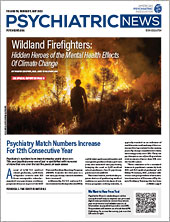Patients with schizophrenia appear to be at a lower risk of hospitalization for physical health issues when taking high doses of two or more antipsychotic medications concurrently (polypharmacy) than when taking just one antipsychotic medication (monotherapy) at the same equivalent dose, according to a
study published in March in
AJP in Advance. “When patients were treated with high-dose antipsychotic monotherapy, … they had approximately a 20% higher risk of severe cardiovascular outcomes leading to hospitalization compared with periods when the same patients were treated with corresponding high-dose combination therapy,” wrote Heidi Taipale, Ph.D., an assistant professor at the Karolinska Institutet, and colleagues.
The study included data collected from 61,889 patients diagnosed with schizophrenia who were alive on January 1, 1996, and had received inpatient care as documented in Finland’s nationwide Hospital Discharge register. Taipale and colleagues tracked these patients until December 31, 2017, or their death, whichever occurred first. They specifically compared the patients’ nonpsychiatric and cardiovascular hospitalizations during periods when they were receiving antipsychotic polypharmacy versus monotherapy.
The researchers also compared differences in outcomes according to antipsychotic exposure by further dividing the groups according to the following defined daily doses (DDDs): <0.4, 0.4 to <0.6, 0.6 to <0.9, 0.9 to <1.1, 1.1 to <1.4, 1.4 to <1.6, and ≥1.6. (A DDD of 1.0 reflects the average dose of a medication prescribed to an adult, according to the
World Health Organization.)
Here are some of the study’s findings:
•
About 46.4% of patients had used high-dose (≥1.6 DDDs/day) monotherapy, and 52.6% had used high-dose polypharmacy.
•
During the follow-up period (about 15 years), 45,013 patients experienced nonpsychiatric hospitalization, and 13,893 experienced cardiovascular hospitalization.
•
The risk of nonpsychiatric hospitalization was 13% lower when patients were taking high-dose antipsychotic polypharmacy versus high-dose monotherapy.
•
The risk of cardiovascular hospitalization was 18% lower when patients were taking high-dose antipsychotic polypharmacy versus high-dose monotherapy.
In an accompanying editorial in the May issue of AJP, Robert W. Buchanan, M.D., a professor of psychiatry at the University of Maryland and the Maryland Psychiatric Research Center, said the study results are part of an emerging body of evidence that calls into question the belief that antipsychotic polypharmacy is less safe than antipsychotic monotherapy.
He wrote that the advent of new antipsychotic medications with mechanisms of action that are not limited to dopamine D2 receptor antagonism—such as aripiprazole, brexpiprazole, cariprazine, and lumateperone—makes rational polypharmacy more likely to be safe and effective. “In particular, the authors note the decreased hospitalization risk associated with the combination of clozapine and aripiprazole,” he wrote.
But Buchanan noted that neither the AJP study nor the previous studies supporting polypharmacy “examined the relative occurrence of less medically serious side effects that may not lead to hospitalization or death but are still troublesome to the person treated with these medications, such as extrapyramidal symptoms, sedation, and diminished mental acuity. ... [T]he relative lack of high-quality studies and comprehensive assessment of adverse events in the reviewed studies limits the conclusions that can be drawn from this review.”
In their report, Taipale and colleagues wrote that some current treatment guidelines categorically encouraging use of monotherapy instead of polypharmacy “are not based on evidence and should take a more agnostic approach to this issue.”
APA’s Practice Guideline for the Treatment of Patients With Schizophrenia, Third Edition, states that for patients who do not respond to a medication, “augmentation treatment can also be considered, although a trial of clozapine should not be delayed by multiple attempts at augmentation therapy.”
The guideline also states, “Particularly for patients with negative symptoms or depression, augmentation of antipsychotic therapy with an antidepressant medication may also be helpful. Use of a benzodiazepine, such as lorazepam, is also suggested in patients who exhibit catatonia. Other augmentation approaches (antipsychotics, anticonvulsants, benzodiazepines, lithium) have also been studied, although evidence is mixed and primarily from small, short-term open-label studies.
“For combination therapy with two antipsychotic medications, data from a large
nationwide cohort study suggest that emergency visits and rehospitalization rates may be reduced in individuals receiving polypharmacy as compared with monotherapy (Tiihonen et al., 2019). In addition, there is no evidence that combining drugs is any more harmful than using a single medication, beyond the common side effects from each drug. Nevertheless, if multiple drugs are used, monitoring for benefits and side effects is important, and it is preferable to limit changes in dose to one drug at a time. In addition, if a patient experiences an exacerbation of symptoms while on a stable dose of medication, a reconsideration of the treatment plan is warranted rather than simply adding medications to the existing regimen.”
Laura Fochtmann, M.D., vice-chair of the schizophrenia guideline writing group, told Psychiatric News that the new AJP study “provides additional evidence that polypharmacy may not be as problematic as it was felt to be in the past.”
But she added, “I wouldn’t want to see this study used as a rationale for routine use of multiple antipsychotic medications or for use of high doses of multiple antipsychotic medications at the same time.” ■

